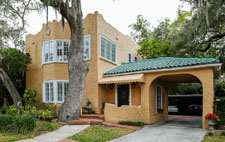
The Beach Park Dream
by Jeanne Wolfe
The excitement of growth reached a fevered pitch in the Tampa of 1923-25 when the jungles of the city’s Interbay Peninsula began to attract the attention of developers, homebuilders, investors, and home buyers. The six mile Gandy Bridge was completed in November of 1924 and further fueled the Beach Park development boom. In December, 1924, the Tampa Sunday Times observed, “Beach Park, one of the most pretentious of all the subdivisions marks the entrance to the Interbay Peninsula. It is situated on Old Tampa Bay just off Memorial Highway. A little over a year ago this property was a wild tropical garden, impregnable and uninhabitable. Today it is a setting for winding streets, parkways, yacht basins and the most magnificent homes in Tampa.”
The Beach Park Company was the brainchild of a leading Tampa real estate firm, The Mabry-Hall Company. They divided the 350 acres of Beach Park into four units, selling lots at $2,750 and “estate-size” parcels for up to $10,000. The firm made headlines in local papers for the record time in which the units were sold. In one hour in November of 1924. $61,150 exchanged hand! That was big money in the 1920s. Half a million dollars worth was sold in 60 days. Speculation was the order of the day and resales after only a few days ownership resulted in average profits of $1600 per transaction.
The popular South Tampa neighborhood of Beach Park is full of architectural variety. The original homes, built in the 1920s, were supposed to maintain the Mediterranean theme. The first Beach Park homes had to be built in conformity to the requirements: stucco exteriors, terra cotta roofs, interior and exterior archways and generous use of decorative tile, they had to be masonry. Those requirements were in case of fire. Beach Park was in the county and had no fire department. The western border of Tampa was Howard Avenue. The Beach Park Company rushed to complete the West Shore entrance by November of 1924 just in time for winter visitors. The Moorish style gates spanned the road and were so well illuminated that they could be seen from Pinellas County. Portions of a smaller set of gates can be seen today at the intersection of Swann and Lois Avenues. The gates marked the entrances to about 70 homes built in the height of Beach Park earliest construction.
The Depression ravaged the Florida real estate market, by 1926 its effects were being felt in Tampa. By the late 1920’s the Beach Park Company had closed its doors and had given its sales office on West Shore to the residents for social purposes. According to Mrs. Carl D. Brorein’s history of Beach Park, “many residents had to give up their homes. Some were sold and others rented by mortgage companies.” Throughout the thirties and forties until the end of World War II, Beach Park was decidedly “rural.”
The dreams of Mr. Mabry, Mr. Hall, Mr. Young and others did not become full-blown reality. Yet, the spirit of their entrepreneurial ambition still flavors the real estate activity in this special Tampa neighborhood. Beach Park residents value the charm of the original Mediterranean style homes. Many of them have been lovingly preserved and are honored with Tampa Preservation Society award banners. The ambiance of Beach Park’s oak trees, palms, azaleas, dogwood, Southern pine and philodendron appeals to many homeowners.
Proximity not only to downtown but also to the airport, interstate, stadium, shopping and West Shore business district remains one of the attractive reasons to choose to live in Beach Park today.
Information contained herein is deemed accurate, however no warranty is implied or given. All linked pages are the sole responsibility of that Web Site and you are requested to verify the accuracy of any content you wish to rely upon. Additionally, any MLS information found on this Web Site or given by Jeanne Wolfe is believed to be accurate, but should be verified to your satisfaction via Appraisers, County Property Records, Personal Observation and the like, before relying upon such information.